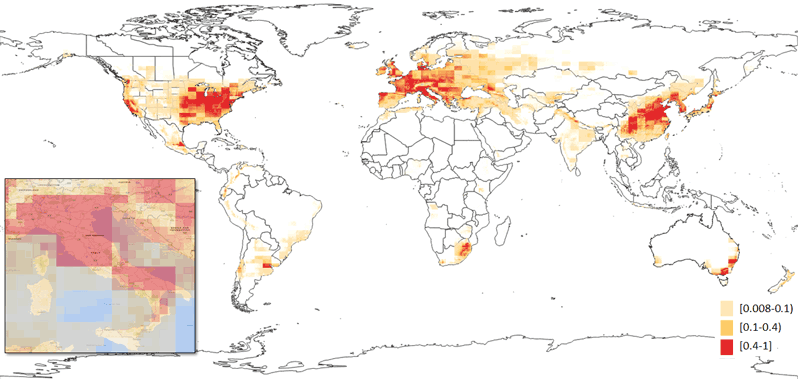by Gianpaolo Coro (ISTI-CNR)
Researchers from ISTI-CNR (Italy) used marine models, designed to monitor species habitats and invasions, to identify the countries with the highest risk of COVID-19 spread due to climatic and human factors. The model correctly identified most locations where large outbreaks were recorded, independent of population density and dynamics, and is a valuable source of information for smaller-scale population models.
The correlation between the reduction of the spread of COVID-19 and season change was foreseen at the beginning of the 2020 pandemic and has been observed during the Northern Hemisphere summer. The models that forecast this correlation ranged from dynamic systems (that constantly monitor the infection’s spatio-temporal spread) and general models that aim to identify global similarities between areas strongly affected by the virus. However, while dynamic systems are still struggling to produce new recommendations to reduce the spread of infection, general models are informing scientists and decision-makers about large-scale trends and ideal conditions for infection. These models can match patterns at a large temporal and spatial resolution and can provide information about the general conditions that support the virus’s persistence, independently of social dynamics. Patterns related to temperature variation have been evident in some parts of the world, and have been used (and sometimes abused) by political authorities to modify regulations.
Among the general models used to explore correlations, ecological niche models (ENMs) have been extensively and effectively used to predict the spread of viruses, including SARS-CoV-2. Generally, an ENM estimates the presence of a particular species in a geographical area by correlating species-specific occurrence records in its native habitat with environmental parameters. The species’ niche is the space within a hypervolume of numerical vectors – corresponding to environmental parameter ranges – that is correlated with the species’ presence and that fosters the species’ persistence in an area. Once a model has estimated the species’ ecological niche, it can then project it across a new geographical area to identify other locations that provide ideal conditions for the species.

Figure 1: Global-scale probability distribution of the COVID-19 infection rate produced by Coro’s (2020) model, with Italy magnified at the lower-left hand side (situation of March 2020).
While COVID-19 is capable of persisting in a range of environments, some populated regions experience lower infection rates than others. Studies using ENMs have pinpointed very interesting similarities between global regions with the highest infection rates. One of these used a Maximum Entropy-based Ecological Niche Model [1] to estimate the COVID-19 infection rate (disease spreading speed) globally at a half-degree spatial resolution. The model identified geographical areas that favour higher infection rates due to their particular geophysical (surface air temperature, precipitation and elevation) and anthropogenic characteristics (CO2 and population density). Relying solely on data from Italian provinces that reported high infection rates in March 2020, the model was then used to predict global regions that were likely to experience high infection rates. Surprisingly, the model highlighted strong similarities between the climatic and anthropogenic characteristics of locations where disease outbreaks have really occurred, e.g. the Hubei province in China, the Western United States, and Europe, and correctly foresaw a high risk of fast disease increment in 77% of the countries that have then reported significant outbreaks. This experiment has highlighted that certain parameter combinations, such as a temperature range of 11 to 12 °C, moderate humidity, and a high level of air pollution, are strongly correlated with a high infection rate. Once above a low threshold, this correlation is also independent of population density. The model also indicates that in some regions (e.g. Brazil, Ecuador and Peru), the high infection rate cannot be explained in terms of the identified environmental factors, with population dynamics possibly being more important than climatic conditions. Overall, this kind of ENM can inform fine-grained dynamic models about which areas have the conditions to be a catalyst of the infection.
One interesting aspect of the ENM [1] is that the model comes from the marine science domain, where it had been used to predict the spread of invasive species [2] and the potential distribution of rare species [3]. The model was directly re-used to predict COVID-19 infection rates because it was based on findable, accessible, interoperable, and reusable (FAIR) data and on an Open Science-oriented methodology that standardised the input, output, and the processing, and thus enhanced the reusability of the model.
The challenge now is to introduce these models into larger decision support systems to increase their prediction accuracy and resolution, and to estimate the risk for individuals to end up in intensive care, based on background data about their environmental and health conditions.
Link:
[L1] Suitability Map of COVID-19 Virus Spread – Experimental Data and Results
References:
[1] G. Coro: “A global-scale ecological niche model to predict SARS-CoV-2 coronavirus infection rate”, Ecological Modelling, 431, 109187, 2020.
[2] G. Coro, et al.: “Forecasting the ongoing invasion of Lagocephalus sceleratus in the Mediterranean Sea”, Ecological Modelling, 371, 37-49, 2018.
[3] G. Coro, C. Magliozzi, A. Ellenbroek, P. Pagano: “Improving data quality to build a robust distribution model for Architeuthis dux”, Ecological modelling, 305, 29-39, 2015.
Please contact:
Gianpaolo Coro, ISTI-CNR, Italy











